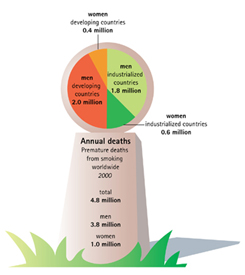Center for Communications, Health and the Environment

Immediate Action Required: Understanding the Tobacco Epidemic and Stopping It in Its Tracks
by Dr. Judith Mackay, Director, Asian Consultancy on Tobacco Control, Kowloon, Hong Kong, and Director of Global Tobacco Control Programmes, and Project Coordinator, Bloomberg Initiative to Reduce Tobacco Use, World Lung Foundation
Within 150 years of Columbus finding “strange leaves” in the New World, tobacco had made its way across theglobe. More than 500 years later, at the beginning of the 21st century, about one-third of adults throughout the world used tobacco. Today, “tobacco...is responsible for about 5 million deaths worldwide every year,” laments Dr. John R. Seffrin, chief executive officer of the American Cancer Society. And if current trends continue through 2025, it will kill 10 million individuals globally each and every year, with 7 million of these deaths occurring in the developing world.
Tobacco is the globe’s biggest killer. No other consumer product is as dangerous, or kills as many people. It led to the deaths of 100 million smokers in the 20th century, and, if left unchecked, 10 times as many – more than 1 billion people – are estimated to die from tobacco use in the 21st century. In fact, tobacco will eventually kill about 650 million smokers alive today. That’s about 10 percent of the current total global population! [See Full Lead Article]
Q&A With Dr. Judith Mackay
Dr. Judith Mackay, Director, Asian Consultancy on Tobacco Control, Kowloon, Hong Kong, and Director of Global Tobacco Control Programmes, and Project Coordinator, Bloomberg Initiative to Reduce Tobacco Use, World Lung Foundation
1. What progress has been made in tobacco control since the 2002 Tobacco Atlas was published?
An astonishing amount of progress has been made, but first the bad news:
- The number of smokers is rising, mainly due to population expansion in developing countries.
- The number of tobacco deaths is increasing.
- Global tobacco consumption is rising.
Thus, the epidemic is not being reduced; it is expanding, and is being transferred from the rich to the poor countries, which can least afford the economic burden.
The good news is that:
- Systems are being put in place that will eventually reduce this epidemic. Of this I am certain, but it will take a long time.
- The WHO Framework Convention on Tobacco Control (FCTC), the world's first public health treaty, is one of the fastest-track UN treaties of all time. It currently has 168 signatories, and more than 150 states are parties to it.
- Donors to tobacco control are increasing. For example, with an initial two-year donation of US$125 million, the Bloomberg Initiative to Reduce Tobacco Use represents the largest-ever effort to fight tobacco in low- and middle-income countries . The initiative, which employs about 120 people, supports resource offices, a grants programme, training in tobacco control as well as in finance and budgeting, prevalence and tobacco-control surveys, and advocacy.
- The prevalence rates of male smoking are falling in most places in the world, and the predicted rise of smoking among women in developing countries has not occurred.
- Many nations have implemented strong tobacco-control measures.
Several international, regional and national tobacco-control meetings have taken place; and journals such as Tobacco Control continue to expand, while articles on tobacco are appearing in other publications. [Read Full Q&A with Dr. Mackey]

Dr. Sushma Palmer, Program Director
Valeska Stupak, Editorial & Design Consultant
Shiraz Mahyera, Systems Manager
Rohit Tote, Website Consultant